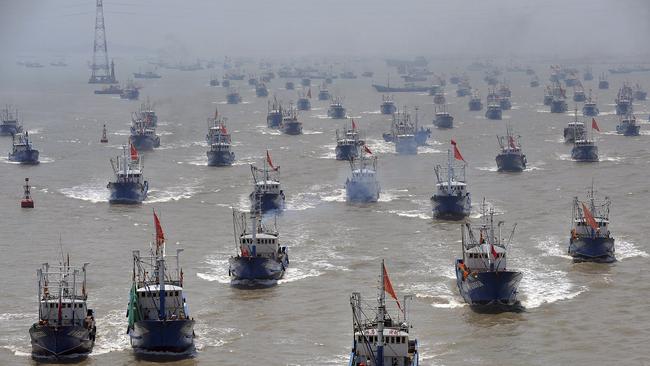China’s military funds and trains hundreds of fishermen to challenge us

This fishing militia presents two problems for Australia: its aggressive tactics against a country such as The Philippines or Japan risks dragging us into a wider conflict; and how would we deal with hundreds of these mercenaries swarming towards Australian waters? This is guerrilla warfare on the high seas on a huge scale.
These state-sponsored mercenaries form part of the People’s Armed Forces Maritime Militia. Based at China’s Hainan Island, the fishing fleet receives weapons and fuel subsidies. The “fishermen” also train with the People’s Liberation Army Navy. As The Economist reported in March 2017, they are part of China’s power projection. They are deployed to take territory and target anyone challenging China’s claim to the whole of the South China Sea. A fortnight ago more than 100 fishing boats were harassing the Japanese-administered Senkakus. Four years ago 230 swarmed the same islands.

Our region is not the only area being plundered and tested. Last month about 340 Chinese trawlers swarmed into Ecuadorean waters. In 2017 a Chinese trawler was captured in the Galapagos Marine Reserve carrying 300 tonnes of marine wildlife. Last year the Argentina coastguard opened fire on a Chinese vessel fishing in the country’s exclusive economic zone.
Australia is yet to be tested. It is one thing to turn back illegal people-smuggling boats, quite another to confront this Chinese Communist Party-controlled and well armed flotilla.
Retired US Navy admiral James Stavridis said in a 2017 paper the Chinese government was directly militarising worldwide theft of ocean resources. Former Indonesian fishing minister Susi Pudjiastuti described China’s actions as “transnational organised crime”.
Conventional military hardware will remain fundamental to Australia’s security. The Morrison government’s $270bn defence systems upgrade across 10 years is a recognition of just how serious we take future threats. Yet hundreds of small boats, armed to the teeth, sporadically mobilising in our northern waters would be more difficult to hit and less costly to lose. They also could be employed to take and hold ground in strategic locations around Papua New Guinea, the Solomons and other nearby jumping off points. And of course if we push back China would respond that its fleet was just fishing.
Last year a Chinese vessel rammed and sank a Philippine fishing boat, but it also sank the then burgeoning relationship between Philippines President Rodrigo Duterte and China.
Last week Philippines Foreign Secretary Teodoro Locsin Jr said if China attacked one of its naval vessels The Philippines would call in the US, enacting their 69-year-old Mutual Defence Treaty.

Australia’s history with The Philippines has been strengthening since World War II. Both fought together in the Korean War. In 1995 the Joint Defence Co-operation Committee was signed and in 2012 a Status of Visiting Forces Agreement was entered into. Australia supported the Armed Forces of The Philippines in neutralising Islamic State insurgents in Marawi on the southern Philippines island of Mindano. In 2017 inaugural Navy-to-Navy Strategy talks kicked off following the 2015 Comprehensive Partnership. The upshot of all this is Australia would find it hard not to come to the aid of The Philippines, especially if the US were involved.
Plundering the resources of other economies and swarming into territorial waters are acts of aggression disguised as civilian activities and a cheaper alternative to conventional conflict for opponents of the US and its allies such as Australia. The future of conflict, as it always has been, will be based on the tactics of imaginative asymmetric warfare. The CCP’s use of fishing mercenaries is a good use of imagination.
The CCP assault is on all fronts: academe, media, critical infrastructure, agriculture, fisheries, data, resources, intellectual property and now a virus. For the CCP there is no distinction between civilian and military. And none of it involved even throwing a rock, let alone a multi-million-dollar piece of military hardware.
British security specialist Edward Lucas observed the predominant view of war in the West was that it “only occurs when formal or informal forces engage each other using kinetic force”. Hard to believe we are still coming to terms with that concept.
A bully is often hiding some kind of personal insecurity. The bullying rarely continues when faced with a courageous opponent or one with many allies. It appears confronting the CCP, whether on the high seas state or elsewhere, requires both approaches. In the meantime, we risk our own security and those of our partners if we dismiss these state-sponsored maritime fighters as underpaid fishermen.
Jason Thomas teaches risk management at Swinburne University of Technology and is director of Frontier Assessments.







The poisoned tip of China’s arrow is its vast armed fishing militia. Notorious for swarming the economic waters of other nations — The Philippines, Vietnam and Indonesia — its mission is to expand China’s area of denial. It is grey-zone warfare, warfare without firing a shot.